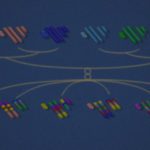Lien vers Pubmed [PMID] – 1712888
Brain Res. Mol. Brain Res. 1991 May; 10(2): 159-66
We have investigated the phylogenetic distribution of the glial fibrillary acidic protein (GFAP) in lens epithelial cells (LEC) of various mouse species within the genus Mus. We have shown that lens GFAP is expressed in mice of the Mus musculus complex and in Mus spicilegus and Mus macedonicus species (L.GFAP(+) phenotype) while it is absent in Mus spretus, Mus caroli and Mus cooki species (L.GFAP(-) phenotype). Our results argue in favour of one of the phenograms illustrating the probable phylogenetic relationships between these species in the genus Mus. In animals where lens GFAP was immunodetected, Northern blots of lens RNA extracts hybridized with a mouse GFAP cDNA probe, revealed a single 2.7 kb band. Comparative Northern blot analysis of lens tissue from L.GFAP(+) mice or of brain tissue from L.GFAP(+) or L.GFAP(-) mice did not show any size heterogeneity of the GFAP mRNA. The pattern of the GFAP immunostaining of astroglial cells in brain was identical in both L.GFAP phenotypes. Analysis of interspecific crosses showed that the L.GFAP(+) character is transmitted in a dominant fashion and seems to be linked to the Mus musculus Gfap gene. In this study we have also confirmed the localization of the mouse Gfap gene on chromosome 11.

